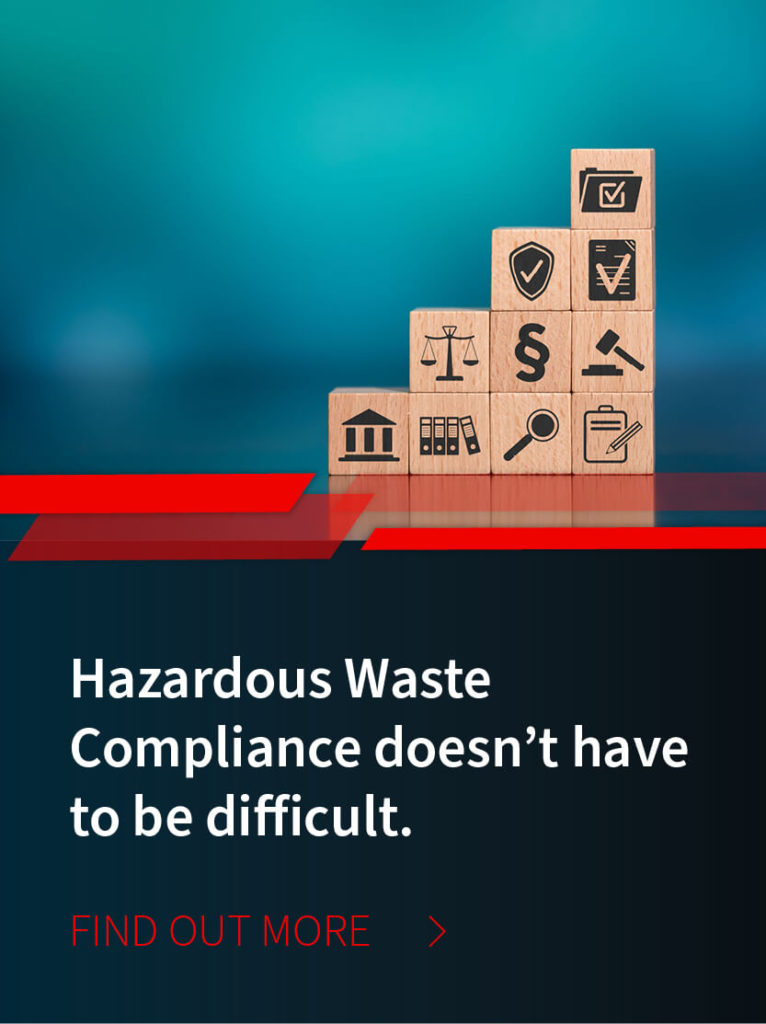
/ IN THIS BLOG
Managing waste at a college or university isn’t just about dumpsters and recycling bins. With science labs, maintenance shops, art studios, and campus clinics all producing different types of waste, proper documentation becomes critical, especially when hazardous materials are involved.
That’s where two key documents come in: the hazardous waste manifest and the bill of lading (BOL). While both are essential to legal and compliant waste shipments, they serve very different purposes. And on a busy, multi-department campus, the line between them can sometimes get blurred.
So, are these documents any different for colleges? After all, your facility isn’t a big major manufacturing factory. The short answer is no, documentation regulations aren’t any different for higher education institutions. But, that doesn’t mean there aren’t a few important campus-specific considerations worth noting. From navigating RCRA regulations to avoiding common compliance pitfalls, here’s what your college or university needs to know to remain safe and compliant.
01 / Shipping Manifest vs. Bill of Lading: What’s the Difference?
While both the hazardous waste manifest and the bill of lading (BOL) are used to document waste shipments, they are not interchangeable. Knowing which one to use is essential for campus compliance.
When to Use a Shipping Manifest
A hazardous waste manifest is required for any shipment of waste that meets the EPA’s definition of hazardous under RCRA regulations. This includes chemical waste from science labs, certain cleaning agents from facilities teams, or hazardous medical waste materials from campus clinics. It’s a federally regulated, standardized form that tracks hazardous waste from the point of generation to the final treatment or disposal facility.
When a Bill of Lading is Necessary
A bill of lading, on the other hand, is used for non-hazardous waste or special waste not regulated under federal hazardous waste laws. On college campuses, this could include items like biomedical waste, document shredding residue, spent oil absorbents, or empty containers. Unlike the manifest, there’s no universal format. Bill of ladings (BOLs) are often generated by individual waste vendors and can vary by state or company.
Understanding which document applies to each waste stream is key to maintaining proper college waste management records and avoiding regulatory missteps.
02 / Are Manifests and BOLs Different for Colleges?
This is an important question to ask, because in some instances, places of higher education have different standards than commercial businesses. However, from a regulatory standpoint, hazardous waste manifests and bills of ladings must be handled the same way and there’s no difference for colleges. Whether you're a university, a hospital, or a private manufacturer, the forms and the legal requirements are the same. All generators must comply with the same federal (and often state) rules when it comes to documentation.
What makes colleges unique isn’t the paperwork, but the complexity of campus waste streams. Universities often have diverse departments generating waste under one EPA ID, including:
Chemistry and biology labs
Facilities and maintenance departments
Fine arts studios
Medical clinics and health centers
Agricultural or engineering programs
This many different waste streams creates a complex web of compliance challenges and responsibilities that can easily lead to errors if departments operate in silos. Miscommunication or inconsistent training are common obstacles that often result in incorrect forms, misclassified waste, or missing documentation. Since any of these missteps can trigger violations during an inspection, it’s essential for college leadership to prioritize proper documentation.
Creating centralized oversight can solve many of these challenges and bring much needed organization to the campus. For instance, many schools benefit from bringing a campus environmental health and safety (EH&S) officer or waste management coordinator onto the leadership team. This expert can provide guidance, while verifying documents and conducting periodic internal audits. This proactive approach helps universities ensure waste documentation is consistent, accurate, and audit-ready across departments.
Campus-Specific Pitfalls to Avoid
Colleges and universities face unique challenges when it comes to managing hazardous and non-hazardous waste documentation. With multiple departments, rotating student staff, and varied types of waste, even well-intentioned systems can break down. Here are some common compliance pitfalls and how to avoid them:
Mixing up documentation: Using a bill of lading for hazardous waste (or vice versa) is a common error. Make sure all departments understand which form applies to each type of waste.
Inaccurate or incomplete forms: Missing signatures, incorrect waste codes, or incomplete tracking details can trigger violations. Double-check every manifest and BOL before pickup.
Decentralized compliance responsibilities: If each department handles its own documentation without coordination, inconsistencies are almost guaranteed. Centralize oversight whenever possible.
Untrained personnel: Lab assistants, student workers, or new faculty may not be fully aware of waste handling protocols. Provide recurring training and maintain clear SOPs.
Lack of internal audits: Regular self-checks can catch small errors before they turn into costly violations. Audits also prepare your campus for official EPA inspections or state reviews.
Staying on top of college waste management requires more than just having the right forms. You’ll also want to make sure to educate your team so the right people are using each form correctly and consistently.
Further complicating matters, rules for medical waste disposal are often written and enforced by more than one state agency. Consider:
In most states, the EPA is responsible for developing and enforcing regulations for medical waste management. But in some, the Department of Health is involved (e.g., Missouri and Oklahoma) or might even be the primary enforcer (e.g., Colorado)
03 / The e-Manifest System Update: What Colleges Need to Know
The EPA’s e-Manifest system is transforming how hazardous waste is tracked and colleges need to be prepared. As of January 22, 2025, under the EPA’s Third Final Rule, Large Quantity Generators (LQGs) and Small Quantity Generators (SQGs) must be registered with the e-Manifest system to retrieve completed manifests. That means no more waiting for paper copies from the receiving facility.
This change has direct implications for campus EH&S teams and waste management coordinators:
Registration is mandatory for LQGs and SQGs. Each campus must maintain at least one registered user in the EPA’s RCRA Info system.
Paper manifests will no longer be mailed. All final signed copies will be available only through e-Manifest accounts, even for hybrid manifests that begin as paper.
The manifest form itself is changing. Colleges must switch to the new 4-copy EPA Form 8700-22 and continuation sheet (Form 8700-22A). The outdated 5-copy forms will no longer be accepted after December 1, 2025.
Export manifests and exception reports must now be submitted electronically through e-Manifest, and generators are responsible for correcting any data errors.
For colleges, this shift means rethinking how manifests are managed across campus. EH&S teams should double check that internal workflows and filing systems are prepared for digital access and retrieval. Regular coordination with waste vendors and transporters will also be essential to ensure seamless transition.
Here at MCF Environmental, we’ve been helping numerous organizations update their practices to keep up with the current changes. Because while the system aims to improve university waste documentation and regulatory oversight, it also introduces new responsibilities. That makes it even more important to work with partners familiar with both higher education and evolving EPA compliance standards, like MCF.
Why Proper Documentation Matters
At MCF we understand that few people look forward to more paperwork. But for a college campus, waste documentation isn’t just another piece of red tape. It’s an effective way to help protect people, the environment, and the educational institution itself. Whether it’s a hazardous waste manifest or a bill of lading, accurate documentation plays a critical role in several areas:
Safety: Clear records ensure that anyone handling the waste, from campus staff to transporters to emergency responders, knows exactly what they’re dealing with and how to respond if something goes wrong.
Compliance: Inaccurate or missing forms can lead to fines, failed inspections, or enforcement actions. With EPA penalties rising and new digital systems like e-Manifest in place, attention to detail is more important than ever.
Efficiency: Coordinated documentation across departments helps streamline pickups, avoid scheduling errors, and prevent delays in disposal.
Liability protection: Thorough, well-maintained records are your best defense in the event of an audit, investigation, or legal issue.
The cost of poor documentation isn’t just financial, it can affect safety, reputation, and the smooth functioning of academic and research operations.
04 / MCF Environmental Supports College & University Waste Management
Managing hazardous and non-hazardous waste across an academic campus can be a complex task. But, it doesn’t have to be overwhelming! MCF Environmental has decades of experience partnering with colleges and universities to simplify compliance, improve documentation practices, and ensure safe, legal waste disposal.
We understand the unique challenges that come with managing multiple waste streams across diverse departments. From chemistry labs and art studios to dining services and campus health centers, we help institutions:
Navigate hazardous waste manifest and bill of lading requirements
Transition to and manage the EPA’s e-Manifest system
Coordinate pickups and documentation across departments
Train campus personnel on labeling, segregation, and form accuracy
Stay audit-ready with centralized, compliant recordkeeping
Whether you’re updating your internal processes or looking for better ways to address the new EPA Third Rule changes, MCF can serve as your trusted partner in college waste management. We offer both hands-on waste management services and regulatory guidance tailored to higher education environments.
Need help managing your college’s hazardous or non-hazardous waste? MCF Environmental offers full-service waste disposal, compliance consulting, and documentation support tailored to the needs of colleges and universities. Let’s simplify your processes, reduce risk, and keep your campus compliant. Contact us today to get started.
05 / FAQ: Hazardous Waste Manifest and Bill of Lading for Colleges
What’s the difference between a hazardous waste manifest and a bill of lading?
A hazardous waste manifest is a federally regulated form required for transporting hazardous waste. A bill of lading (BOL) is used for non-hazardous or special waste and is typically vendor-specific. Colleges use both, depending on the type of waste being shipped.
Do colleges use different documentation than other waste generators?
No. Colleges must follow the same RCRA and DOT regulations as other generators. The variety of waste streams and departments involved can make compliance more complex on college campuses.
When do colleges need to start using the EPA’s e-Manifest system?
This deadline has passed. January 22, 2025 was the deadline for making the switch when all Large and Small Quantity Generators (LQGs and SQGs) must be registered in the e-Manifest system to access finalized manifests. The old 5-copy form will be fully phased out by December 1, 2025.
Who’s responsible for filling out these forms on campus?
Responsibility can vary, but best practice is for a centralized environmental health and safety officer or waste management coordinator to oversee documentation. This will help ensure consistency across departments. This expert can also help conduct internal reviews to keep a campus audit-ready.
Robert Losurdo
President, COO








